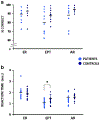Neural correlates of the core facets of empathy in schizophrenia
- PMID: 22306196
- PMCID: PMC7988185
- DOI: 10.1016/j.schres.2011.12.018
Neural correlates of the core facets of empathy in schizophrenia
Abstract
Empathy is a multidimensional construct composed of several components such as emotion recognition, emotional perspective taking and affective responsiveness. Even though patients with schizophrenia demonstrate deficits in all core components of this basic social ability, the neural underpinnings of these dysfunctions are less clear. Using fMRI, we analyzed data from 15 patients meeting the DSM-IV criteria for schizophrenia and 15 matched healthy volunteers performing three separate paradigms tapping the core components of empathy, i.e. emotion recognition, perspective taking and affective responsiveness. Behavioral data analysis indicated a significant empathic deficit in patients, reflected in worse performance in all three domains. Analysis of functional data revealed hypoactivation in a fronto-temporo-parietal network including the amygdala in patients. Moreover, amygdala activation correlated negatively with severity of negative symptoms. The results suggest that schizophrenia patients not only suffer from a broad range of emotional deficits but also show cortical and subcortical abnormalities, extending previous findings on fronto-temporal cortical dysfunctions. Since empathy is related to psychosocial functioning and hence of high clinical relevance in schizophrenia, a more detailed understanding of the exact nature of these impairments is mandatory.
Copyright © 2011 Elsevier B.V. All rights reserved.
Conflict of interest statement
Conflict of interest
All authors declare no conflict of interest.
Figures




References
-
- Amunts K, Kedo O, Kindler M, Pieperhoff P, Mohlberg H, Shah NJ, Habel U, Schneider F, Zilles K, 2005. Cytoarchitectonic mapping of the human amygdala, hippocampal region and entorhinal cortex: intersubject variability and probability maps. Anat. Embryol 210 (5–6), 343–352. - PubMed
-
- Aschenbrenner S, Tucha O, Lange KW, 2000. Regensburger Wortflüssigkeits-Test, RWT. Hogrefe, Göttingen.
-
- Benedetti F, Bernasconi A, Bosia M, Cavallaro R, Dallaspezia S, Falini A, Poletti S, Radaelli D, Riccaboni R, Scotti G, Smeraldi E, 2009. Functional and structural brain correlates of theory of mind and empathy deficits in schizophrenia. Schizophr. Res 114 (1–3), 154–160. - PubMed
Publication types
MeSH terms
Substances
Grants and funding
LinkOut - more resources
Full Text Sources
Medical

